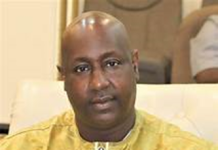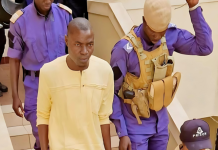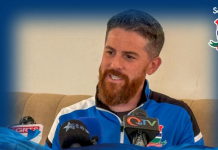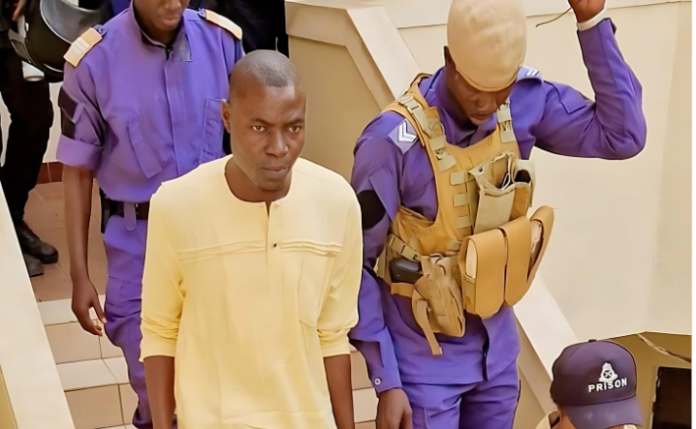By Kemeseng Sanneh (Kexx)
Senior Lawyer Lamin J. Darboe has stated that the case against Ousainou Bojang is a fabrication. He mentioned this in his written argument in the application he made for “no case submission.”
Ousainou Bojang is accused of killing two policemen at the Sukuta-Jabang Traffics Light in September 2023. After the prosecution called 13 witnesses and closed their case, Lawyer Lamin J. Darboe representing Ousainou Bojang made a ‘no case submission’ seeking to get his client’s acquittal with the argument that the prosecution failed to establish a case against him.
Ousainou Bojang is charged with murder contrary to section 187 of the Criminal Code. On the particulars of the offence, it is alleged that Ousainou Bojang on or about 12 September 2023 at Sukuta, West Coast Region caused the death of Police Constable Sang J. Gomez by shooting him with a gun. While committing the alleged crime, the prosecution alleged that he did so with malice.
Count 2 is also on murder and particulars are the same as count 1. The only difference is this one relates to the death of Police Constable Pateh Jallow.
On count 3, Ousainou is charged with Prohibition of Acts of Terrorism contrary to section 3 (1)(a) of the Anti-Terrorism Act. The prosecution alleged that on or about 12 September 2023 at Sukuta, West Coast Region, Ousainou Bojang attacked Police Constable Pateh Jallow and Police Constable Sang J Gomez by shooting them with a gun which resulted in their death.
He is also charged with attempt to murder contrary to section 200 of the Criminal Code on count 4. The prosecution alleged that during the same day and place, he unlawfully attempted to cause the death of Police Constable Ansey Jawo by shooting her with a gun.
On the fifth and final count, he is charged with assault causing grievous bodily harm contrary to section 214 of the Criminal Code. It is alleged that on the same day and place, he unlawfully shot police Constable Ansey Jawo with a firearm occasioning her grievous bodily harm.
Ousainou denied all the charges and a plea of not guilty was entered for him. Senior Lawyer LJ Darboe said the court is required to determine in the ‘no case submission’ whether the prosecution has established a case against Ousainou Bojang.
Lawyer Darboe said all of the charges preferred against Ousainou Bojang emanated from the terrorist attack on the three police officers at the Sukuta-Jabang Traffic Lights. Section 3(1) (a) of the Anti-Terrorism Act states “A person who does an act of terrorism commits an offence and is liable on conviction to be sentenced to death” while section 2 (c) (i) of the Anti-Terrorism Act provides that acts of terrorism include “attacks on a person’s life which may cause death.”
Darboe said under the Second Schedule of the same law (Anti-Terrorism Act) it is mandated that the video recording of a person detained during his or her period of detention should be taken. He added that section 60 provides that it shall be carried out in such manner as to constitute an accurate, continuous, and uninterrupted record of the whole period of his or her detention including his or her movements, interviews, and statements. He maintained that keeping a video recording of the detention is a legal requirement.
“Further, it is respectfully submitted that the entire evidence of the State’s 13 witnesses cannot support a conviction against the 1st Accused without the Honourable Court engaging in speculation,” he said.
Darboe said in The Gambia like in many countries, ballistic testing is crucial in an alleged murder case. The law likely requires forensic analysis of any firearms or ammunition found at the crime scene to determine if they match the weapon suspected of being used in the crime. This helps establish the chain of evidence and strengthen the prosecution’s case. Ballistic forensics is the art of examining evidence relating to firearms at a crime scene, including the effects and behaviour of projectiles and explosive devices. In this sense, what the Ballistic forensic expert does is match bullets, fragments, and other available evidence with recovered weapons of suspected perpetrators of crime or those that are party to a dispute. It is also the science of identifying the particular gun that a recovered bullet or cartridge case came from. Ballistic forensic experts may be required to give evidence based on their findings in civil or criminal matters.
Lawyer LJ Darboe said the importance of ballistic evidence is very important especially if firearms and guns were used in the act of committing a crime. However, the lack of forensic evidence may lead to the discharge or acquittal of the accused since the requirement of the law is that there should be a nexus that connects the accused to the crime concerning the ballistics provided by the prosecution. He cited some decided cases regarding the issue of DNA reports.
He said it is important to indicate that even though there was a ballistic report, there was no evidence that connected Ousainou Bojang to the gun.
“Considering the nature of the crime, the gun should have been subjected to forensic DNA or fingerprint examination to confirm if the 1st Accused [Ousainou] was at any point in contact with the said gun. PW8 specifically admitted there was no fingerprint to connect the 1st Accused with the gun. It was fundamental that the ballistic report was accompanied by a DNA or fingerprint report showing that the accused was at some point in contact with the gun,” he said.
He stated that there should be Forensic DNA to serve as a nexus (link or connection) between the accused and the ballistic evidence. It is important to note that because there was a DNA or fingerprint examination, the prosecution could have linked the accused to the crime and in the case at hand, there is no DNA or fingerprint, and the gun was not found in the possession of Ousainou.
Barrister Darboe said forensic officer Mr Francis Jatta informed the court that the murder weapon was found on the 22nd of September 2022 in consequence of which it could not be subjected to DNA or fingerprint examination because it was exposed to the heat and there was a high possibility that the user will likely not be traced. Furthermore, the murder weapon was disassembled according to the witnesses that testified before the court and what was presented in court was an assembled gun.
“Presenting an assembled weapon is alarming considering the fact the forensic officer advised the Army to examine the weapon based on how it was submitted to them and they disregarded that instruction and the casings presented before the court were different in shape and size,” he said.
He stated that it is dangerous to convict based on the uncorroborated confession of an accused person. He said the principle of ‘corpus delicti’ forbids conviction solely on the defendant’s confession and requires that there be independent evidence proving each element of the offense, albeit not identifying the defendant as the perpetrator. He added that in some jurisdictions, the rule also regulates the admissibility of statements, and the prosecution must establish a prima facie case with independent evidence before a confession can be admitted. He made reference to some cases.
He said there was no evidence given by the prosecution witnesses to prove that the accused has both the motive and capability to commit the crime he was charged with. He added that there was no evidence outside the confession either direct or circumstantial that goes to show that its contents are true.
“There was no evidence given in court connecting the 1st Accused to the commission of the crime,” he said.
As for the alleged gun used in the killings and the other items seized from the 1st Accused person’s home and workplace, he said nothing is connecting Ousainou to those items of clothing, shoes, and other things.
“Undoubtedly, forensic analysis is vital to criminal investigation because a person cannot be at the scene of a crime without leaving something behind and cannot leave the scene of the crime without taking something with him in consequent of which conducting a Forensic DNA and fingerprints in addition to the ballistic report considering the nature of the punishment of this crime is essential because there is no way the 1st Accused could have used the gun and other items of clothing without his DNA on them,” he said.
















